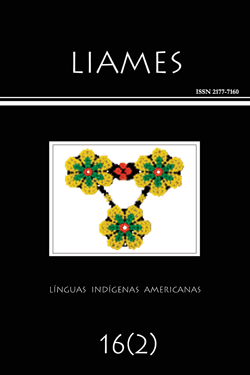Abstract
The goal of this short paper is to address additional facts related to the process of full labial palatalization (or coronalization) proposed in Carvalho (2016a) for Yawalapiti, an Arawak language of central Brazil. After discussing the broader theoretical significance of the full palatalization of labials to typology and to the theory of sound change, I will show that the identification of the correspondences supporting the recognition of this development in Yawalapiti can be traced back to Karl von den Steinen's 1894 publication of the earliest available documentation of the Xinguan Arawak languages. Next, I argue that a pattern of allomorphy in the 2sg prefix of Yawalapiti can be understood as a relic of the series of sound changes that mapped a labial stop *p to a coronal consonant in palatalization-prone environments. Finally, I note that this labial coronalization change has the status of a drift-like tendency within the Xinguan Arawak subgroup, a fact underscored by its independent occurrence in Waurá. Furthermore, a relatively late date can be assigned to this development on the basis of a comparison of recent data on this language with the vocabularies found in the Von den Steinen material.References
Aikhenvald, Alexandra Y. (1999). The arawak language family. In R. M. W. Dixon; Alexandra Aikhenvald Y. (eds.) The Amazonian languages, pp. 65-106. Cambridge: Cambridge University Press.
Bateman, Nicoleta (2007). A crosslinguistic investigation of palatalization (Doctoral Dissertation). San Diego: University of California.
Bondim, Renata, G. (1976). Língua yawalapiti (Aruák): Dados coletados na aldeia yawalapiti (Xingu). CNPq/CEPG/UFRJ. 2 Vols. [Report on fieldwork activities archived at the CELIN, Museu Nacional, Universidade Federal do Rio de Janeiro (MN/UFRJ), Rio de Janeiro, Brasil) ]
Brandão, Ana Paula (2014). A reference grammar of paresi-haliti (Arawak) (Doctoral Dissertation). Texas: University of Texas at Austin.
Captain, David; Captain, Linda (2005). Diccionario básico ilustrado wayuunaiki-español, español-wayuunaiki. Bogotá: Editorial Buena Semilla.
Carvalho, Fernando O. de (2016a). Internal and comparative reconstruction in Yawalapiti: Palatalization and rule telescoping. International Journal of American Linguistics 82(3): 285-316. doi:10.1086/687384
Carvalho, Fernando O. de 2016b. The diachrony of person-number marking in the lokono-wayuunaiki subgroup of the arawak language family: Reconstruction, sound change and analogy. Language Sciences 55: 1-15.
Carvalho, Fernando O. de (2016c). Obscure cognates and lexical reconstruction: Notes on the diachrony of the Xinguan Arawak Languages. Boletim do Museu Paraense Emílio Goeldi 11(1): 277-294.
Corbera Mori, Angel (2008). Una aproximación a las lenguas arahuacas del Brasil Central. Cristina Messineo; Marisa Malvestitti; Roberto Bein (eds.). Estudios en Lingüística y Antropología. Homenaje a Ana Gerzenstein, pp. 27-38. Buenos Aires: Editorial Facultad de Filosofía y Letras. Universidad de Buenos Aires.
Corbera Mori, Angel (2012). Waurá e Mehinaku: Um breve estudo comparativo. Estudos Linguísticos 41(1): 196-205.
https://revistas.gel.org.br/estudos-linguisticos/article/view/1226/779
Corbera Mori, Angel (2014). Un breve esbozo tipológico de la palatalización en mehinaku (Arawak). In Maria Malvestitti; Patricia Dreidemie (comps.). Libro de Actas del III Encuentro de Lenguas Indígenas Americanas (ELIA), pp. 159-170. Universidad Nacional de Río Negro.
Corbera Mori, Angel (2015). Una aplicación del método restitutivo en la interpretación fonético-fonológica de la lengua Kustenaú (Arawak). Paper presented at the II ALFALITO Conference, Universidad Nacional de La Plata, Argentina, April 21-24, 2015.
Danielsen, Swintha (2007). Baure: An arawak language of Bolivia. Indigenous Languages of Latin America (ILLA) 6. Leiden: CNWS Publications.
Eastlack, Charles (1968). Terena (Arawakan) pronouns. International Journal of American Linguistics 34(1): 1-8.
Ekdahl, Elizabeth M.; Butler, Nancy (1979). Aprenda terena, vol. 1. Brasília: Instituto Linguístico de Verão (ILV).
Hamano, Shoko (2000). Voicing of obstruents in Old Japanese: Evidence from the sound-symbolic stratum. Journal of East Asian Linguistics 9(3): 207-225.
Janda, Richard; Joseph, Brian (2003). Reconsidering the canons of sound change: towards a ‘Big-Bang’ Theory. In Barry Blake; Kate Burridge (eds.). Historical Linguistics 2001: Selected Papers from the 15th Conference in Historical Linguistics., pp. 205-219. Amsterdam: John Benjamins.
Krishnamurti, Bhadriraju (2003). The dravidian languages. Cambridge: Cambridge University Press.
Meléndez Lozano, Miguel Angel (2011). Diccionario bilingüe achagua-español, español-achagua. Bogotá: Universidad de los Andes.
Ohala, John (1978). Southern bantu vs. the world: The case of palatalization of labials. Proceedings of the Annual Meeting of the Berkeley Linguistics Society 4: 370-386.
Ortega Mujica, Mitzila I. (1992). Aspectos fonológicos e gramaticais da língua yawalapiti (Aruak) (Master’s Thesis): Campinas, S.P.: UNICAMP.
Parker, Stephen (1995). Datos de la lengua iñapari. Lima: Summer Institute of Linguistics.
Payne, David (1991). A classification of Maipuran (Arawakan) languages based on shared lexical retentions. In Desmond C. Derbyshire; Geoffrey K. Pullum (eds.). Handbook of Amazonian Languages, vol. 3, pp. 355-499. Berlin: Mouton de Gruyter.
Postigo, Adriana Viana (2014). Língua wauja (Arawak): Uma descrição fonológica e morfossintática (Doctoral Dissertation). Araraquara, SP.: UNESP.
Richards, Joan (1988). Estrutura verbal waurá. Série Linguística 9: 197-218.
Santos, Manuel Gomes dos (2006). Uma gramática do wapixána (Aruák): Aspectos da fonologia, da morfologia e da sintaxe. (Doctoral Dissertation): Campinas, SP.: UNICAMP.
Seki, Lucy; Aikhenvald Y. Alexandra (1992). Estudo histórico-comparativo das línguas Arawak do Xingu. Paper presented at the VII Encontro da ANPOLL, Porto Alegre, 17-20 May 1992.
Silva, Glauber Romling (2009). Fonologia da língua paresi-haliti (Aruák). (Master’s Thesis). Rio de Janeiro: UFRJ.
Thomason, Sarah G. (1986). On changes from palatalized labials to apical affricates. International Journal of American Linguistics 52(2): 182-186.
von den Steinen, Karl (1894). Unter den Naturvölkern Zentral-Brasiliens:
Reiseschilderung und Ergebnisse der Zweiten Schingú-Expedition (1887-1888). Berlin: Hoefer & Vohsen.
The LIAMES: Línguas Indígenas Americanas uses the Creative Commons license (CC), thus preserving the integrity of the articles in an open access environment.


